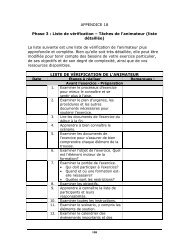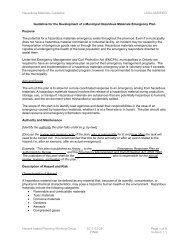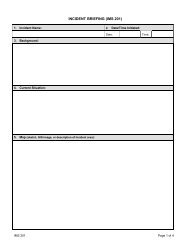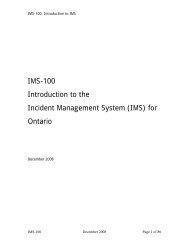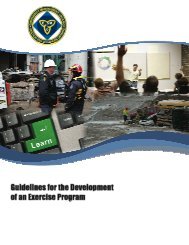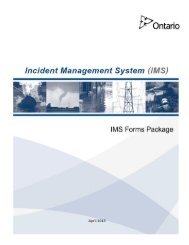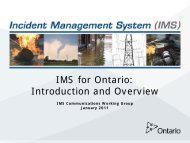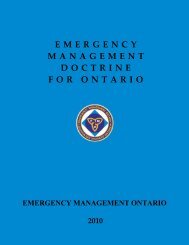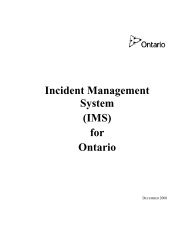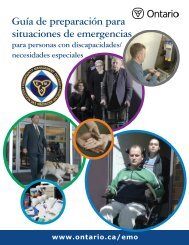Energy
PDF Version - Emergency Management Ontario
PDF Version - Emergency Management Ontario
- No tags were found...
You also want an ePaper? Increase the reach of your titles
YUMPU automatically turns print PDFs into web optimized ePapers that Google loves.
Ministry of<br />
<strong>Energy</strong><br />
Emergency Management Ontario
Preface<br />
This document was prepared by the Ministry of <strong>Energy</strong> (ENERGY) and Emergency<br />
Management Ontario (EMO). In the course of preparing this document, the Ministries<br />
requested and received information from various industry participants. However,<br />
the views and statements in this document are entirely those of the Government<br />
of Ontario. They are not attributable to any industry participants.<br />
EMO, part of the Ministry of Community Safety and Correctional Services, in conjunction<br />
with ENERGY, have developed this fuel distribution Protocol in the event<br />
of a declared Provincial emergency with a fuel shortage.<br />
EMO and ENERGY received information from the Ontario Division of the Canadian<br />
Petroleum Products Institute (CPPI), and on an individual basis, from the four major<br />
oil companies (Imperial Oil, Shell, Suncor, and Ultramar) operating in Ontario<br />
that CPPI represents, as well as other oil companies. The information received<br />
from CPPI was generic publically available information about how the industry operates.<br />
In addition, individual oil companies provided information to ENERGY under<br />
strict confidence on a one on one basis.<br />
This Protocol also incorporates resources of independent petroleum marketers that<br />
are represented by the Canadian Independent Petroleum Marketers Association<br />
(CIPMA). CIPMA members operate hundreds of retail fuel outlets throughout Ontario.<br />
CPPI members are responsible for all the refining and much of the distribution<br />
operations in Ontario. CPPI members, CIPMA members and independent operators<br />
not represented by any other association, all have retail operations in Ontario.<br />
In order to ensure compliance with the Federal Competition Act, CPPI has requested<br />
and EMO and ENERGY have agreed that they will seek any competitively<br />
sensitive information they require from oil companies on an individual basis,<br />
and will maintain all such information in strict confidence.<br />
No competitively sensitive information from any oil company may be shared with<br />
any other oil company.<br />
Competitively sensitive information includes, but is not limited to, information on<br />
pricing, market shares, customers, sales or marketing strategy, production levels<br />
or capacity, inventory levels, channels or methods of distribution, supply and demand<br />
levels, margins or prices at which products are resold, and responses to<br />
bids or tenders. It may also include information about the capability and capacity<br />
of facilities.<br />
2
Table of Contents<br />
1.0 Introduction................................................................................................................ 4<br />
2.0 Aim............................................................................................................................ 4<br />
3.0 Authority..................................................................................................................... 4<br />
4.0 Compliance with Federal ‘<strong>Energy</strong> Supplies Emergency Act’..................................... 4<br />
5.0 Imminent Fuel Shortage............................................................................................ 4<br />
6.0 Response Plan.......................................................................................................... 4<br />
7.0 Notification................................................................................................................. 7<br />
8.0 Communications........................................................................................................ 5<br />
9.0 Emergency Management and Civil Protection Act.................................................... 5<br />
10.0 Plan Review………………………………………………………………………………... 5<br />
Appendix<br />
A Critical Infrastructure Sectors……………………………………………………………. 6<br />
B Best Practices - for Critical Infrastructure Owners/Operators and Communities….. 7<br />
Business Continuity Plans……………………………………………………………….. 7<br />
Recommendations Regarding Stationary Emergency Power Generators………….. 7<br />
Critical Infrastructure Response Vehicles………………………………………………. 8<br />
C Fuel Capacity at Community Levels…………………………………………………….. 8<br />
D Designated Emergency distribution Terminals…………………………………………. 9<br />
E Temporary Waivers from Governments………………………………………………… 10<br />
F Stakeholder Responsibilities…………………………………………………………….. 11<br />
Emergency Management Ontario……………………………………………………….. 11<br />
Ministry of <strong>Energy</strong>…………………………………………………………………………. 12<br />
Canadian Petroleum Products Institute…………………………………………………. 12<br />
Canadian Independent Petroleum Marketers Association (CIPMA)..………………. 13<br />
Pipeline Operators………………………………………………………………………... 13<br />
Individual Oil Companies…………………………………………………………………. 13<br />
Communities……………………………………………………………………………….. 13<br />
Critical Infrastructure Owners and Operators………………………………………….. 14<br />
Ministries…………………………………………………………………………………... 14<br />
3
Ontario Government Emergency Fuel Distribution Protocol<br />
1.0 Introduction<br />
For the purposes of this Protocol,<br />
„fuel‟ refers to refined petroleum<br />
products, such as gasoline,<br />
diesel, jet fuel and heating<br />
oil but not crude oil.<br />
A fuel supply shortage can be<br />
caused by failures in the distribution<br />
system (e.g. due to<br />
truckers‟ protests) and/or major<br />
disruptions to refinery operations (e.g. significant<br />
electrical outages or fire). During a declared emergency,<br />
supplies of fuel may become a government<br />
controlled commodity in order for communities and<br />
critical infrastructure (CI) sectors to maintain essential<br />
services.<br />
2.0 Aim<br />
The Protocol outlines how communities and designated<br />
CI sectors (Appendix A) will work towards prioritized<br />
fuel distribution in the event of a shortage in a<br />
declared Provincial emergency.<br />
3.0 Authority<br />
This Protocol is executed under authority prescribed<br />
by Ontario‟s Emergency Management and Civil Protection<br />
Act and its regulations.<br />
4.0 Compliance with Federal ‘<strong>Energy</strong> Supplies<br />
Emergency Act’<br />
In the event that the Governor in Council implements<br />
the Federal „<strong>Energy</strong> Supplies Emergency Act’ [R.S.<br />
1985, c. E-9] in response to an exceptionally severe<br />
interruption in the supply of crude oil, this Provincial<br />
Protocol will be subject to and comply with any applicable<br />
measures that may result.<br />
5.0 Imminent Fuel Shortage<br />
Should a potential fuel shortage be the predictable<br />
result of circumstances that allow for advance notice,<br />
individual CPPI members shall advise ENERGY. In<br />
turn, ENERGY shall notify the Provincial Emergency<br />
Operations Centre (PEOC) Duty Operations Officer.<br />
Should a fuel shortage be the sudden result of circumstances<br />
that provide no advance notice, ENER-<br />
4<br />
GY will consult with PEOC and EMO staff to develop<br />
an effective strategy to mitigate the effects of the<br />
shortage.<br />
6.0 Response Plan<br />
EMO and ENERGY have developed a three tiered<br />
escalating response Protocol designed to facilitate<br />
emergency fuel distribution. This Protocol is consistent<br />
with EMO‟s doctrine of a „bottom-up‟ approach,<br />
where communities generally respond to incidents<br />
first before requesting assistance from the Province if<br />
the situation is beyond their capability. Critical infrastructure<br />
sectors are considered to be essential service<br />
providers and users of fuel.<br />
Tier 1: CIs and communities have robust emergency<br />
Plans and are prepared to be self-sufficient for three<br />
days.<br />
Tier 2: Communities and CIs are to assist each other<br />
through prearranged mutual aid assistance agreements.<br />
(Formal or informal agreements between CIs, as well as<br />
between communities, are also recommended.)<br />
Tier 3: The PEOC shall assist CIs and municipalities as<br />
a last resort. PEOC will strategically prioritize requests.<br />
EMO‟s doctrine also calls for individuals, businesses<br />
and communities to prepare for self sufficiency for<br />
three days. The doctrine also recommends that mutual<br />
aid assistance agreements should be developed<br />
as a best practice. CIs and communities should develop<br />
mutual aid agreements because most CIs reside<br />
in the communities they serve and most resources<br />
are at the community level. Therefore, it is of<br />
mutual benefit to both parties. Appendix B highlights<br />
some of the best practices for CIs and communities to<br />
follow.<br />
ENERGY estimates that only a<br />
small percentage of the approximately<br />
3,800 retail gas stations<br />
in Ontario have backup power<br />
generators. ENERGY staff will<br />
obtain information from individual<br />
oil companies to prepare a list<br />
of retailers with backup generators,<br />
which will be kept confidential<br />
by ENERGY Staff. In a declared<br />
emergency, this information<br />
will be used by Ontario
Ontario Government Emergency Fuel Distribution Protocol<br />
Government staff, as required, in a manner which<br />
best preserves public safety and confidentiality.<br />
CI sectors with response vehicles that rely on fuel retailers<br />
and do not have their own fuel depots should<br />
develop mutual aid with communities they serve. CIs<br />
should also develop a list of retailers with backup generators<br />
in the area they serve. They can canvass<br />
branded and independent stations to determine if they<br />
have a generator.<br />
Most communities have a designated emergency fuel<br />
depot with a backup power generator enabling it to<br />
operate during an electricity outage (Appendix C).<br />
These communities have established contracts with<br />
fuel suppliers. In most emergency situations, their<br />
regular supplier should be able to re-supply their fuel<br />
depot provided that the supplier has a robust contingency<br />
plan (see Appendix B for Best Practices for CIs<br />
and Communities).<br />
At Tier 3, the PEOC can assist CIs and communities<br />
with their fuel requests. The PEOC will strategically<br />
prioritize the request and ENERGY will then contact<br />
the applicable CPPI member company emergency<br />
operations centre and attempt to arrange for fuel delivery.<br />
Each oil company has individually designated<br />
emergency fuel distribution terminals in Ontario<br />
(Appendix D).<br />
The PEOC can work with appropriate Ministries to<br />
implement temporary waivers that will provide oil<br />
companies with flexibility to increase fuel supply and<br />
ease a severe shortage situation (Appendix E).<br />
When a community or CI is unable to obtain fuel from<br />
its regular supplier and has exhausted all other resource<br />
options such as an alternate fuel supplier, mutual<br />
aid from other communities, or other resource<br />
options as identified in their emergency plans, they<br />
shall advise the PEOC Duty Operations Officer at<br />
(416) 314-0472 or 1-866-314-0472.<br />
The requesters should provide the following information<br />
to the PEOC: justification of need for priority,<br />
type of fuel, quantity required, expected operational<br />
time before depletion, name of regular supplier, location,<br />
contact information and other relevant information.<br />
8.0 Communications<br />
ENERGY will communicate with individual oil<br />
companies to ensure up-to-date and accurate<br />
information is provided to make appropriate decisions<br />
by Ministry senior management in conjunction<br />
with the PEOC Executive group, and in a<br />
manner that is fully compliant with the Competition<br />
Act.<br />
The Ontario Emergency Management Structure will<br />
provide unified communication messages to all stakeholders<br />
that are consistent, clear, accurate and timely.<br />
9.0 Emergency Management and Civil Protection<br />
Act<br />
It is imperative that CIs and communities develop robust<br />
business continuity plans with strong fuel contingencies.<br />
It is important to utilize all possible re-<br />
invoke emergency powers and orders under Section 7<br />
In a declared Provincial emergency, the Province may<br />
sources before requesting assistance for fuel from the of the Emergency Management and Civil Protection<br />
PEOC at Tier 3, because there may be many requests<br />
from CIs and communities and the PEOC will<br />
Act to control the use and or distribution of fuel.<br />
need to strategically prioritize these requests. Thus,<br />
fuel requests may not be filled on time.<br />
10.0 Protocol Review<br />
Appendix F contains a list of stakeholder responsibilities,<br />
Page 11.<br />
In consultation with stakeholders, this Protocol shall<br />
be reviewed annually and updated as required by<br />
EMO and ENERGY. Any changes will be reviewed by<br />
stakeholders.<br />
7.0 Notification<br />
5
Ontario Government Emergency Fuel Distribution Protocol<br />
Appendix A - Critical Infrastructure Sectors<br />
EMO has identified nine critical infrastructure sectors. The PEOC/EMO has not pre-determined the priority<br />
of these nine CI sectors. Depending on the nature of the emergency, priority will be determined at an appropriate<br />
time during a declared provincial emergency by strategic assessment<br />
C o n t i n u i t y o f G o v e r n m e n t<br />
(municipal, provincial and federal governments).<br />
Oil and Natural Gas (oil refineries,<br />
distribution and retail operations; natural<br />
gas distribution).<br />
Electricity (nuclear, hydroelectric and<br />
fossil power generation; electricity<br />
transmission and distribution).<br />
Financial Institutions (Bank of Canada,<br />
banks and trust companies, credit<br />
unions, caisses populaires, Province<br />
of Ontario Savings Office, interinstitution<br />
computer systems, insurance<br />
companies, mutual fund companies,<br />
stock exchanges).<br />
Food and Water (water treatment,<br />
water storage, water monitoring, water<br />
distribution, waste water and sewage<br />
treatment, food production and harvesting,<br />
food processing and distribution,<br />
food inspection and monitoring).<br />
Health (hospitals, ambulance services,<br />
pharmaceuticals, blood services,<br />
and long-term care facilities).<br />
Public Safety and Security (fire<br />
fighting, police and emergency medical<br />
services, emergency operations<br />
and evacuation centres, Centre of Forensic<br />
Sciences, Office of the Chief<br />
Coroner, military facilities, correctional<br />
facilities, search and rescue, flood and<br />
erosion control, pollution monitoring<br />
and public alerting, weather forecasting<br />
and public alerting);<br />
Telecommunications (9-1-1 communications,<br />
telephones, wireless telephones,<br />
pagers, television stations,<br />
radio stations, internet); and<br />
Transportation (highways and<br />
roads, snow removal services, railways,<br />
public transit, airports, aviation<br />
communication and navigation, port<br />
facilities, canals and shipping locks,<br />
movable bridge systems, ferries, marine<br />
communication and navigation,<br />
border controls);<br />
The preceding list is in alphabetical order and not in prioritized order. Nevertheless, it is recognized that most<br />
of the CI sectors will be unable to operate without an ongoing supply of fuel. The list is a generic guide only<br />
and not intended to provide a complete and exhaustive description of all possible essential users in each CI<br />
sector.<br />
6
Ontario Government Emergency Fuel Distribution Protocol<br />
Appendix B - Best Practices for Critical<br />
Infrastructure Owners and Operators<br />
& Communities<br />
As part of the emergency planning process, communities<br />
and CIs should consider measures that can be<br />
taken in advance to mitigate the potential effects of a<br />
fuel shortage.<br />
All communities and CIs should have a robust emergency<br />
preparedness and response plan to deal with<br />
threats.<br />
Strategically located sources of auxiliary electrical<br />
power generators with adequate capacity and on-site<br />
fuel reserves can increase the robustness of continuity<br />
of operations.<br />
Ideally, communities and CIs should prepare to be<br />
self sufficient for three days as prescribed by EMO<br />
guidelines.<br />
The development of a robust business continuity plan<br />
(BCP) will enhance the operational resilience of organizations.<br />
Business Continuity Plans<br />
advance of and during a fuel supply disruption.<br />
Ensure clear and concise pre-approved messages<br />
are ready, as well as a means of communicating<br />
them to key stakeholders.<br />
Maintain emergency contact list of critical staff and<br />
stakeholders.<br />
Maintain an emergency operations centre and alternate<br />
site.<br />
Keeping a supply of critical parts / commodities to<br />
ensure continuity of service.<br />
Mutual aid, sharing resources and or expertise<br />
with other organizations.<br />
Keep details of alternative suppliers should primary<br />
supplier fail.<br />
Car sharing or alternative modes of transport for<br />
essential staff.<br />
Lodging facilities for critical staff.<br />
Information technology plan / strategy.<br />
Interdependencies with other CIs / organizations.<br />
Incident management system.<br />
Staff training and awareness.<br />
Weather or seasonal patterns that may affect<br />
BCP.<br />
Review and exercise BCP regularly.<br />
Recommendations regarding Stationary Emergency<br />
Power Generators<br />
BCP should consider and include the following:<br />
Emergency management coordinator to develop<br />
and maintain BCP.<br />
Hazard identification and risk assessment.<br />
Mitigation, preparedness, response and recovery<br />
measures / strategies.<br />
Identify all fuel supply vulnerabilities and prepare<br />
for them.<br />
Establish firm contract with fuel supplier and ensure<br />
supplier has a robust contingency plan. This<br />
could include backup power generators at retail<br />
sites and distribution terminals.<br />
Identify, prioritize and reallocate resources<br />
(including staff) to deliver only critical services and<br />
products.<br />
Reducing fuel usage and conserving where possible.<br />
Improving the resilience of service contracts and<br />
supply chain management (not just fuel but other<br />
supplies the organization needs to deliver its key<br />
services and products).<br />
Establish effective communication with staff, customers,<br />
suppliers and other key stakeholders in<br />
Generators should be properly maintained and<br />
tested under load on a regular basis. Ensure fuel<br />
quality and quantity level are maintained.<br />
CIs and communities should have a firm contract<br />
with a fuel supplier. They should ensure that their<br />
supplier understands that CIs and communities<br />
are a high priority in an emergency situation.<br />
They should also ensure their supplier has a robust<br />
contingency plan. The potential declaration<br />
of a Provincial emergency and the use of force<br />
majeure should be considered in contract discussions.<br />
CIs and communities should consider diversifying<br />
the fuel supplies for their life-safety emergency<br />
and backup generation fleet by including continuously<br />
piped natural gas from the gas utility whose<br />
service is independent of the electrical grid. Retrofitting<br />
existing diesel generators to operate on a<br />
combination of diesel and natural gas, commonly<br />
referred to as bi-fuel or dual-fuel, may be practical.<br />
Its main advantage is to extend the run-time of the<br />
stored diesel fuel inventory and thus increase<br />
7
Ontario Government Emergency Fuel Distribution Protocol<br />
resiliency of operations.<br />
Appendix C: Fuel Capability at Community Level<br />
CIs should develop mutual aid assistance agreements<br />
(where possible) with the community in<br />
which they serve. Communities should recognize<br />
that CIs are a priority in the response and recovery<br />
efforts and in most cases, CIs serve in their<br />
communities, thus it is of mutual benefit to both<br />
parties. Agreements between CIs, as well as between<br />
communities, are also recommended.<br />
CI Response Vehicles<br />
Vehicles‟ fuel tanks should be filled to capacity at<br />
the end of each work shift.<br />
A survey was conducted to determine the fuel capability<br />
at the community level in February/March of<br />
2007. The survey was forwarded to all 445 communities<br />
in Ontario via EMO. Responses from the survey<br />
provided a summary of fuel resources at the community<br />
level. The survey was crafted by ENERGY and<br />
CPPI.<br />
Analysis from the responses indicated the following:<br />
168 responses were completed, representing a<br />
response rate of about 38 per cent. This represents<br />
a sufficient sample size that may be indicative<br />
of the fuel resources at the community level.<br />
CIs should develop a list of retail gas stations with<br />
backup power generators in the geographic area<br />
they serve. They can canvass branded and independent<br />
gas stations to determine if they have a<br />
generator. (There are hundreds of stations being<br />
operated by independent owner/operators that are<br />
not represented by CPPI, CIPMA or any other trade<br />
association.)<br />
Consider having a variety of fleet vehicles running<br />
on different fuels. For example, gasoline, diesel,<br />
hybrid, propane, natural gas and electric powered<br />
vehicles would provide greater flexibility and resilience.<br />
CIs should develop mutual aid assistance agreements<br />
with the communities in which they serve.<br />
Agreements between CIs, as well as between communities,<br />
are also recommended.<br />
Most communities have a designated emergency<br />
fuel depot with a backup power generator enabling<br />
it to operate during an electricity outage.<br />
These communities have established contracts<br />
with fuel suppliers. A few smaller communities<br />
rely on private retail outlets, probably due to a lack<br />
of resources. Larger communities have many municipally<br />
operated depots.<br />
Community designated fuel depots mostly provide<br />
service to fire and road maintenance vehicles.<br />
Other first responder vehicles (police, EMS and<br />
utilities) not serviced by a municipal depot likely<br />
use retail outlets or card locks.<br />
Most communities do not have a fuel delivery vehicle<br />
to supply stationary generators at hospitals<br />
and water and sewage treatment plants. They<br />
rely on their fuel supplier for delivery to stationary<br />
generators. A small percentage of communities<br />
have tanks attached to pickup trucks and are able<br />
to deliver to generators.<br />
Most community fuel depots contain regular gasoline<br />
and on-road and off- road diesel. Their depots<br />
contain sufficient supply for their operational<br />
needs, able to sustain their vehicles for a number<br />
of days before the need to refuel storage tanks.<br />
Their usage is generally higher in the winter due<br />
to snow removal operations.<br />
Most communities are receptive to mutual aid<br />
agreements with CI sectors. Some are receptive<br />
to assisting CI sectors without agreements with<br />
their fuel needs in the event of an emergency.<br />
Most communities advised that their own needs<br />
must be fulfilled first before assisting others.<br />
8
Ontario Government Emergency Fuel Distribution Protocol<br />
Some communities will not be able to assist because<br />
they do not have a fuel depot or their capacity<br />
is insufficient. The decision to assist CIs<br />
usually needs the approval of their municipal<br />
council.<br />
A small number of communities do not have a<br />
designated emergency fuel depot. They rely on a<br />
local fuel supplier through a contract arrangement<br />
or depend on retail service stations or card lock<br />
facilities to meet their needs.<br />
These results suggest that most communities are fuel<br />
self sufficient for a few days. They are willing to assist<br />
CI sectors provided that their needs are met first.<br />
It is a good practice for CI sectors to arrange mutual<br />
aid agreements with communities, as most CIs serve<br />
communities and most resources reside at the community<br />
level. Therefore, it is of mutual benefit to both<br />
parties.<br />
Appendix D: Designated Emergency Distribution Terminals<br />
Individual oil companies have designated nine terminals for fuel distribution in a Provincial emergency with a fuel shortage.<br />
Designated Emergency Distribution Terminals<br />
Company Terminal Name Terminal Location Hard Wired for Generator<br />
Generator<br />
On Site<br />
Suncor Oakville Oakville Yes Yes<br />
Suncor Thunder Bay Thunder Bay Yes Yes<br />
Ultramar Ltd. Maitland Maitland Yes Yes<br />
Ultramar Ltd. Bracebridge Gravenhurst Yes No<br />
Ultramar Ltd. Sudbury Sudbury Yes No<br />
Shell Canada Sault Ste Marie Sault Ste Marie Yes No<br />
Suncor Metro Depot Toronto Yes Yes<br />
Suncor London London Yes Yes<br />
Imperial Oil Ottawa Ottawa Yes No<br />
Terminal operations adhere to all government regulations/protocols/Technical Standards and Safety<br />
Authority (TSSA) requirements to ensure compliance and safety at all times:<br />
All loading will be performed under the existing oil company specific protocols and procedures<br />
at the facility.<br />
Tank farms will be manned; an operator will inspect for leaks hourly and will have two-way<br />
communications to the office.<br />
All facilities have spill containment facilities, including but not limited to dikes, oil/water separators<br />
and controlled catch basins that comply with the LFHC.<br />
9
Ontario Government Emergency Fuel Distribution Protocol<br />
Appendix E: Temporary Waivers from Governments<br />
The following types of temporary waivers from Government<br />
may provide oil companies with flexibility to<br />
increase fuel supply and ease a severe shortage situation.<br />
Other waivers may be available to alleviate an<br />
emergency situation.<br />
Gasoline Volatility Limit<br />
The Ontario Ministry of the Environment can grant a<br />
temporary waiver of the gasoline volatility limit in the<br />
ethanol-in-gasoline regulation to allow the blending of<br />
ethanol with conventional gasoline, (ethanol is normally<br />
blended with a special, low-volatility blendstock<br />
known as RBOB to meet volatility limits) or the use of<br />
other components in gasoline to extend supply.<br />
Liquid Fuels Handling Code<br />
The Technical Standards and Safety Authority (TSSA)<br />
under the Ontario Ministry of Consumer Services can<br />
grant temporary variances under its Liquid Fuels Handling<br />
Code.<br />
Hours of Service Rules for Fuel Haulers<br />
The Ontario Ministry of Transportation can grant temporary<br />
provision to relax hours of service rules for fuel<br />
haulers that could maximize refuelling efficiencies to<br />
help in supply and delivery across the province.<br />
Fuel Oil Regulation<br />
The TSSA under the Ministry of Consumer Services<br />
can grant temporary variances under its Fuel Oil Regulation<br />
(Ontario Regulation #213/01, Technical Standards<br />
and Safety Act, 2000).<br />
The regulation requires a fuel supplier to do a thorough<br />
inspection of a customer's fuel tank before delivering<br />
heating fuels like propane and heating oil. Regardless<br />
of whether the tank is underground or above<br />
-ground, the TSSA regulation requires fuel oil distributors<br />
to inspect all equipment to which they deliver fuel<br />
initially and at least once every 10 years.<br />
A temporary variance could allow a fuel supplier to<br />
deliver to a CI location and waive the need to inspect<br />
the equipment when the location is not their regular<br />
customer. It may not be practical to conduct a thorough<br />
inspection in an emergency situation due to time<br />
and resource constraints.<br />
Federal Fuel Regulations<br />
Fuel regulations under the Canadian Environmental<br />
Protection Act (CEPA) 1999 provide environmental<br />
benefits. Regulations covered include:<br />
Gasoline Regulations: limits on lead and phosphorous<br />
Sulphur in Gasoline Regulations: sulphur limits<br />
Sulphur in Diesel Fuel Regulations: sulphur limits<br />
Fuel Information Regulations No. 1: reporting on<br />
additives and sulphur levels<br />
Future fuels regulations made under Division 4<br />
(Fuels)<br />
Benzene in gasoline limits.<br />
CEPA provides for the possibility of waivers of fuel<br />
regulations. CEPA Section 147 provides for the<br />
granting of temporary waivers to regulations in the<br />
Fuels Division under “prescribed circumstances”.<br />
Since regulations have not been passed to prescribe<br />
such circumstances, granting of waivers cannot be<br />
considered.<br />
There may be circumstances when the Government<br />
of Canada may want to waive the fuel regulation. For<br />
example, in the event of a severe fuel shortage, relaxing<br />
fuel quality requirements may help with fuel supply.<br />
In order to use waivers, a regulation must first be developed<br />
setting out the circumstances under which a<br />
waiver may be granted.<br />
If enabled, waivers would be available only for the<br />
fuels regulations under CEPA‟s Fuels Division.<br />
Waivers cannot be applied to regulations made under<br />
CEPA Toxics Substance Part (Part 5) such as the<br />
Benzene in Gasoline Regulations.<br />
10
Ontario Government Emergency Fuel Distribution Protocol<br />
A high threshold is set for waivers:<br />
Waivers would only be possible under extreme<br />
circumstances (e.g. not just for economic reasons).<br />
Should the circumstances occur, granting a waiver<br />
remains at the Minister‟s discretion.<br />
s.147 enables the Minister to waive any of the requirements<br />
of a fuels regulation<br />
Administrative provisions could first be waived,<br />
e.g. reporting<br />
Pollutant limits could later be waived if necessary,<br />
e.g. sulphur content<br />
A waiver is available only under exceptional circumstances<br />
such as when Canada or a province/territory<br />
has declared a state of emergency.<br />
Once an emergency has been declared, the Minister<br />
would then have discretion to grant a waiver. Factors<br />
to be considered by the Minister in granting a waiver:<br />
Does the emergency relate to a fuel supply shortage?<br />
Would the fuel shortage be alleviated by the granting<br />
of a temporary waiver?<br />
Do the benefits of granting a waiver exceed the costs<br />
(e.g. of the resulting impacts on air pollution, the environment<br />
and health of Canadians)?<br />
Implications of granting a waiver and provisions to<br />
mitigate damage.<br />
Appendix F: Stakeholder Responsibilities<br />
EMO/PEOC Responsibilities<br />
EMO to work with ENERGY to ensure that oil sector<br />
critical facilities receive electricity restoration<br />
priority in the event of a disruption, in accordance<br />
with the documented Independent Electricity System<br />
Operator‟s (IESO) Ontario Electricity Emergency<br />
Restoration Plan, where oil refineries and<br />
pipelines are designated as “Priority Customer<br />
Loads”.<br />
Assist communities, ministries and CI sectors with<br />
the development of their respective emergency<br />
fuel contingency plans.<br />
Commissioner of EMO to make recommendations<br />
to the Lieutenant Governor in Council or the<br />
Premier to declare a Provincial emergency.<br />
Commissioner of EMO to make recommendations<br />
to the Lieutenant Governor in Council to implement<br />
emergency powers if necessary.<br />
Commissioner to provide leadership to all facets<br />
of the government‟s emergency management response<br />
and recovery efforts.<br />
Notification to all stakeholders the activation of the<br />
PEOC in a declared emergency.<br />
It is important to note that some fuel made available<br />
under waivers may cause permanent damage to<br />
emissions control equipment on cars and trucks.<br />
Other Federal and U.S. Legislations/<br />
Regulations<br />
The following Federal and U.S. legislations/regulations<br />
would need to be explored:<br />
Ethanol in gasoline waiver.<br />
Truck weight waiver.<br />
Cross border dangerous goods movements.<br />
Export permits from the State of Michigan.<br />
Diesel quality issues.<br />
11
Ontario Government Emergency Fuel Distribution Protocol<br />
Provide strategic priority policies for refueling CIs<br />
and communities. Communicate to stakeholders<br />
that CIs are a priority.<br />
Assist in locating backup power generators for fuel<br />
distribution terminals and retail gas stations that<br />
are hard wired to accept a generator, if necessary.<br />
Field Officers to assist communities with their fuel<br />
needs.<br />
Assist CIs and communities in obtaining emergency<br />
fuel through the PEOC. Prioritize fuel requests.<br />
Assist in arranging security and verification of fuel<br />
request at designated major distribution terminals,<br />
if necessary.<br />
Maintain current 24/7 contact list of Community<br />
and Ministry Emergency Management Coordinators.<br />
Coordinate with appropriate Ministries and/or Federal<br />
departments to implement temporary waivers<br />
to provide oil companies with flexibility to increase<br />
fuel supply.<br />
Resolve any issues and/or priorities.<br />
Lead in Ontario CI Assurance Program.<br />
ENERGY Responsibilities<br />
Maintain the ENERGY Emergency Response Plan<br />
which will include provisions for this Ontario Emergency<br />
Fuel Distribution Protocol. The Protocol will<br />
be reviewed and updated as needed, jointly with<br />
EMO.<br />
Participate in the Ontario CI Assurance Program<br />
and other CI activities. Lead for the oil and natural<br />
gas sector network in the CI program.<br />
Liaise with CI sectors, communities, ministries and<br />
other stakeholders to better understand interdependencies,<br />
address issues and assist in the development<br />
of their emergency fuel contingency<br />
plans.<br />
Provide up-to-date primary and alternate ENER-<br />
GY emergency contact information to the PEOC<br />
Duty Operations Officer.<br />
Provide current emergency contact information to<br />
CPPI and its member representatives and other<br />
oil sector stakeholders.<br />
Advise the PEOC of potential or real fuel shortages.<br />
Consult with the PEOC in developing an effective<br />
strategy to mitigate and/or respond to the<br />
effects of the shortage.<br />
Activate ENERGY Ministry Action Group and<br />
Emergency Operations Centre in support of emergency<br />
fuel management operations.<br />
Communicate EMO/PEOC‟s strategic prioritization<br />
guidelines to CPPI members and other oil sector<br />
stakeholders.<br />
Liaise between the PEOC and CPPI members<br />
with regard to filling fuel requests. Assist in resolving<br />
issues.<br />
ENERGY to work with the Independent Electricity<br />
System Operator (IESO) to ensure that oil sector<br />
critical facilities receive electricity restoration priority<br />
in the event of a disruption, in accordance with<br />
the documented IESO‟s Ontario Electricity Emergency<br />
Restoration Plan, where oil refineries, vital<br />
precursors and pipelines are designated as<br />
“Priority Customer Loads”.<br />
CPPI Responsibilities<br />
1. Provide current primary and alternate CPPI and its<br />
members‟ emergency contact information to EN-<br />
ERGY.<br />
2. Provide current oil sector<br />
critical infrastructure<br />
contact information to<br />
the Independent Electricity<br />
System Operator<br />
for priority system restoration<br />
on an annual<br />
basis (in writing). All<br />
information treated as<br />
strictly confidential and<br />
is not shared other<br />
than with IESO Command<br />
center.<br />
12
Ontario Government Emergency Fuel Distribution Protocol<br />
3. Participate in the following, together with no more<br />
than one CPPI member at a time:<br />
Critical infrastructure exercises;<br />
Attend regular meetings with ENERGY, IESO<br />
and EMO;<br />
Meet with other CI sectors to provide and explain<br />
general non-confidential oil industry information;<br />
and<br />
Attend EMO‟s annual CI conference and workshop<br />
as appropriate.<br />
CIPMA Responsibilities<br />
Liaise with ENERGY and provide list of retail service<br />
stations with backup generator from its member<br />
companies.<br />
Pipeline Operators Responsibilities<br />
Participate in EMO‟s CI Assurance Program. Liaise<br />
through ENERGY with CI sectors and other<br />
stakeholders to address interdependency issues.<br />
Advise the ENERGY of potential or actual emergency<br />
and provide status updates as required.<br />
Individual Oil Companies‟ Responsibilities<br />
Maintain individual emergency preparedness and<br />
response plans with backup power capability<br />
where possible.<br />
Provide current primary and alternate emergency<br />
contact information to the ENERGY Sector Representative.<br />
Advise ENERGY of potential or actual fuel shortages<br />
and provide status updates as required.<br />
Respond to fuel requests from the PEOC/<br />
ENERGY and provide updates on delivery status.<br />
Maintain a list of retail service stations with backup<br />
generators. Provide list to ENERGY on a one<br />
on one confidential basis.<br />
Advise PEOC/ENERGY of any issues in fulfilling<br />
requests should they arise.<br />
On an individual basis, participate with CPPI as<br />
described in CPPI responsibility #3 above.<br />
Communities‟ Responsibilities<br />
Consider developing and maintaining emergency<br />
fuel mitigation, preparedness and response<br />
plan.<br />
Consider developing mutual aid assistance<br />
agreements with other communities and CI sectors<br />
to increase resilience.<br />
Must have a regular fuel supplier for their essential<br />
services and fuel depots and ensure that<br />
their supplier has a robust contingency plan.<br />
Advise their local emergency responders (police,<br />
fire and ambulance) of available designated fuel<br />
depots, if available.<br />
Forecast fuel requirements of essential community/municipal<br />
services and submit requests for<br />
emergency re-supply to their regular fuel supplier.<br />
Through prearrange mutual aid assistance<br />
agreement, assist CIs that serve their community.<br />
At tier 3, provide PEOC with detailed request for<br />
fuel for their community/municipal operations:<br />
justification of need for priority reasons, type of<br />
fuel, quantity required, expected operational<br />
time before depletion, name of regular supplier,<br />
location, contact information and other relevant<br />
information.<br />
Develop priorities within each of their community/municipal<br />
business continuity operations and<br />
conserve fuel where possible.<br />
Adopt best practices in business continuity planning.<br />
13
Ontario Government Emergency Fuel Distribution Protocol<br />
location, contact information and other relevant<br />
information.<br />
Develop priorities within their CI business continuity<br />
operations and conserve fuel where possible.<br />
Adopt best practices in business continuity planning.<br />
Ministries‟ Responsibilities<br />
Consider developing and maintaining emergency<br />
fuel mitigation, preparedness and response plans.<br />
CIs‟ Responsibilities<br />
Consider developing and maintaining emergency<br />
fuel mitigation, preparedness and response plans.<br />
Consider developing mutual aid assistance agreements<br />
with communities and CIs and be able to<br />
tap into community designated fuel depots where<br />
available.<br />
Must have a regular fuel supplier and ensure that<br />
their supplier has a robust contingency plan.<br />
Forecast fuel requirements of essential service<br />
and submit requests for emergency re-supply to<br />
their regular fuel supplier.<br />
Develop a list of retailers with backup generators<br />
in the area they serve. They can canvass branded<br />
and independent stations to determine if they<br />
have a generator.<br />
At tier 3, provide PEOC with detailed request for<br />
fuel: justification of need for priority reasons, type<br />
of fuel, quantity required, expected operational<br />
time before depletion, name of regular supplier,<br />
Consider developing mutual aid assistance agreements<br />
with communities and CIs to increase resiliency.<br />
Must have a regular fuel supplier and ensure that<br />
their supplier has a robust contingency plan.<br />
Forecast fuel requirements of essential service<br />
and submit requests for emergency re-supply to<br />
their regular fuel supplier.<br />
At tier 3, provide PEOC with detailed request for<br />
fuel: justification of need for priority reasons, type<br />
of fuel, capacity requirement, expected operational<br />
time before depletion, name of regular supplier,<br />
location, contact information and other relevant<br />
information.<br />
Develop priorities within their Ministry business<br />
continuity operations and conserve fuel where<br />
possible.<br />
Adopt best practices in business continuity planning.<br />
14
15
Ministry of<br />
<strong>Energy</strong><br />
16



